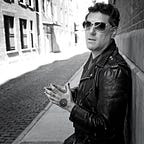Occult Trinity: Austin Osman Spare, William S. Burroughs & Napoleon Hill
The surprising magickal confluence of three diffuse icons
One of the most influential occult figures in the immediate pre- and postwar eras was neither fortuneteller nor wonderworker but rather bravely innovative British graphic artist and writer Austin Osman Spare (1886–1956).
Through Spare’s experiments with breaking structures, rejecting formalism, and seeking to alter reality as we experience it in fleshly forms (our only means of experiencing it, he reckoned), the artist devised an anti-system of externalizing will, creating a visual language for the nonrational, and harnessing magick in a way that required no belief in the extraphysical — or in anything beyond results.
French consciousness theorist Émile Coué (1857–1926) ventured a juxtaposition that applies to Spare’s way of thought: “The French mind prefers first to discuss and argue on the fundamentals of a principle before inquiring into its practical adaptability to every-day life. The American mind, on the contrary, immediately sees the possibilities of it, and seeks . . . to carry the idea further even…
